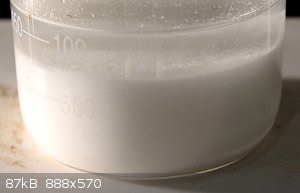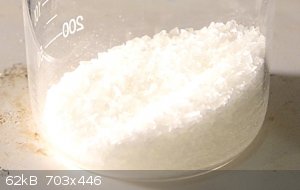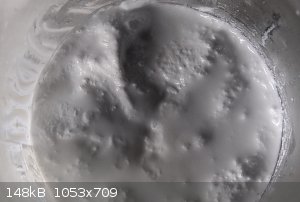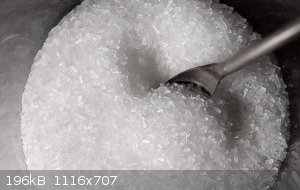| Pages:
1
2
3
4 |
chemplayer...
Hazard to Others
  
Posts: 191
Registered: 25-4-2016
Location: Away from the secret island
Member Is Offline
Mood: No Mood
|
|
Magpie, very interesting to read another attempt at this reaction, and frustrating to read that it's not working out.
Firstly, did you get a noticeable exotherm during the H2O2 addition (especially the first 10-15ml)? We noticed that as the bubbling occurred the
temperature shot up and the mixture required cooling.
Secondly, did you get ammonia evolution occurring during the 'boiling' part of the procedure? (In our video you can see the indicator paper changing
colour as this is evolved.) These seem to be reasonable indications that something useful is happening.
Love to find out what is going on here and why this doesn't seem to be reproducible. We'll be trying this out again at the first possible opportunity
to see if we can do it again and to see if we can do a better analysis of the product (sort of difficult though now because the equipment is all
stashed away).
|
|
|
Magpie
lab constructor
    
Posts: 5939
Registered: 1-11-2003
Location: USA
Member Is Offline
Mood: Chemistry: the subtle science.
|
|
Quote: Originally posted by chemplayer...  |
Firstly, did you get a noticeable exotherm during the H2O2 addition (especially the first 10-15ml)? We noticed that as the bubbling occurred the
temperature shot up and the mixture required cooling.
|
Yes, there was a strong exotherm when adding the H2O2. I had to cool the beaker 3-4 times during the addition of H2O2. I would cool it when the
temperature reached 80°C.
Quote: Originally posted by chemplayer...  |
Secondly, did you get ammonia evolution occurring during the 'boiling' part of the procedure? (In our video you can see the indicator paper changing
colour as this is evolved.) These seem to be reasonable indications that something useful is happening.
|
Yes, there were ammonia vapors continually being evolved during the addition of ammonium bicarbonate.
I didn't do any boiling of the reactants - they probably never exceeded 85°C.
Quote: Originally posted by chemplayer...  |
Love to find out what is going on here and why this doesn't seem to be reproducible. We'll be trying this out again at the first possible opportunity
to see if we can do it again and to see if we can do a better analysis of the product (sort of difficult though now because the equipment is all
stashed away). |
I, too, would really love to find out the cause of the striking discrepancies between your work and mine. Making succinic acid this way would be a
valuable tool for the home chemist.
[Edited on 11-12-2016 by Magpie]
The single most important condition for a successful synthesis is good mixing - Nicodem
|
|
|
AvBaeyer
National Hazard
   
Posts: 644
Registered: 25-2-2014
Location: CA
Member Is Offline
Mood: No Mood
|
|
Magpie,
Perhaps you might want to try a similar but alternate approach to succinic acid from glutamic acid. Dakin published what amounts to a 2 step
oxidation-hydrolysis procedure which provides succinic acid from glutamic acid. He uses chloramine-T as the oxidant though TCCA can also be used. I
have attached the Dakin paper. I have also attached a review of the Strecker degradation (published in Chemical Reviews) which may give you further
insight into your synthesis challenges.
The TCCA paper has a typo in it where "glutaric acid" is used for glutamic acid.
Hope you find these useful.
AvB
Attachment: Dakin_amino acid oxidation.pdf (1.6MB)
This file has been downloaded 1638 times
Attachment: THE STRECKER DEGRADATION OF -AMINO ACIDS1952[1].pdf (889kB)
This file has been downloaded 674 times
Attachment: Conversion of a-Amino Acids into Nitriles TCCA Syncomm2004-34-3449.pdf (95kB)
This file has been downloaded 662 times
|
|
|
Magpie
lab constructor
    
Posts: 5939
Registered: 1-11-2003
Location: USA
Member Is Offline
Mood: Chemistry: the subtle science.
|
|
Thank you for those references AvB. It looks like that last synthesis using TCCA could be used to convert glutamic acid to succinic acid.
The single most important condition for a successful synthesis is good mixing - Nicodem
|
|
|
chemplayer...
Hazard to Others
  
Posts: 191
Registered: 25-4-2016
Location: Away from the secret island
Member Is Offline
Mood: No Mood
|
|
Some very weird and interesting news to report. With food grade (>99%) MSG at hand and some reagent grade c.HCl I had a go at preparing just the
glutamic acid again (no proper glassware though, but accurate weights / measures).
The MSG used was 'Ajinomoto' brand (Japanese import) from a new 500g bag and was in the form of small semi translucent 'shard' crystals, some of which
were quite spiky and pine-needle-like.
50g were dissolved in 90ml of water and then 25ml of c.HCl added. After a very brief pause (1 second perhaps) a thick white precipitate was generated,
and a bit of heat generated in the mixture. The precipitate was then filtered and washed with difficulty.
Observations:
1. The precipitate was much finer than the previous one we captured on video, and formed a mixture more akin to 'plaster of Paris'. It didn't settle
in the mixture as the previous one did.
2. Filtration was much more difficult than before and the solid very difficult to dry substantially. It also formed a 'gel' in the filter where no
water would filter off (even with vacuum) but on agitation 'wetted' and then more water could be removed. This is totally different to what we
previously captured on video.
3. The crystalline appearance of the starting material is very similar to the one we previously used, but is slightly different. The previous material
didn't form the 'needles' and was more cubic in nature.
4. No hard evidence, but the MSG used on this occasion seemed to be slightly less water soluble than in the previous one. Dissolution seemed to be
slower.
The only possible conclusion I can come to is that what we previously used in the experiment, although labelled as 'Aginomoto >99% MSG' could not
have been what it said is was! I will try to track down and see if I can find any archive footage of the original bag and labeling to see if I can
find the exact same brand again! This is somewhat disturbing...
I've checked our inventory list and we did retain the sample of what we thought was succinic acid from the previous experiment that we captured on
video (it is in storage). So I will make an effort to get this out when the opportunity arises (probably the next week or so as chance would have it)
and see if a melting point can be obtained.
Open to any other thoughts or suggestions!
|
|
|
Magpie
lab constructor
    
Posts: 5939
Registered: 1-11-2003
Location: USA
Member Is Offline
Mood: Chemistry: the subtle science.
|
|
Thank you chemplayer for pursuing this discrepancy!
Your observations on making glutamic acid are consistent with what I observed with 3 different OTC sources of MSG. The last was the Aji-No-Moto, a
Japanese company brand, but made in the US. I presume the manufacturing process was Japanese.
You liken the paste to Plaster-of-Paris. I agree. To get a good wash I slurried the 20g or so of the paste in 1000mL of distilled water, then sucked
it damp on a 15cm Buchner filter. The acid was then air dried and ground to a powder with a mortar & pestle.
So, it seems we have some evidence that the MSG you used in making your video may be different in some important way(s) to what is available on the US
OTC market.
It may be worth the effort to obtain some Aji-No-Moto MSG directly from Japan.
The single most important condition for a successful synthesis is good mixing - Nicodem
|
|
|
Cryolite.
Hazard to Others
  
Posts: 269
Registered: 28-6-2016
Location: CA
Member Is Offline
Mood: No Mood
|
|
When I attempted to prepare glutamic acid from MSG, I had much the same experience. I don't recall the brand used, but the branding and text was in
Thai. I dissolved this in water and added excess hydrochloric acid with stirring, and almost immediately a large crop of micocrystalline white product
fell out of solution, jamming the stir bar. To get a product, I ended up having to transfer the thick paste into a larger beaker, adding water, and
pouring the resulting slurry into a fritted funnel.
As far as a test for glutamic acid goes, according to https://www.google.com/patents/US2849468 zinc glutamate is extremely insoluble in water. Maybe adding some zinc chloride solution to the presumed
MSG, and filtering the obtained product would provide a qualitative test for the amount of actual MSG in the obtained material?
|
|
|
chemplayer...
Hazard to Others
  
Posts: 191
Registered: 25-4-2016
Location: Away from the secret island
Member Is Offline
Mood: No Mood
|
|
Yes I trust the Japanese made brand to be what it says it is. I looked through the complete video footage archive and I can't find a shot of the
previous bag of MSG that we used for the video, however I did find separate footage of another experiment (never turned into a video) using the same
starting material (but a different reagent grade HCl source) where we dissolved it and acidified and the result was the same as in the published video
- again, suggesting that it's the startiong material that is the anomaly.
I am intrigued now and might go and buy a few different 'local' brands of MSG powder and see if the results are consistent and if any of them
reproduce the previous results.
Here are some quick photos / screenshots showing the 'mystery MSG' and the acidification product, and the Japanese one (where we are getting
consistent results).
   
|
|
|
AvBaeyer
National Hazard
   
Posts: 644
Registered: 25-2-2014
Location: CA
Member Is Offline
Mood: No Mood
|
|
Here is some information which may help with the conundrum you currently face.
According to Greenstein and Dunitz in "Chemistry of the Amino Acids" V3, pp1929ff, the HYDROCHLORIDE salt of glutamic acid is formed in HCl solution
and its insolubility "far exceeds" that of any other amino acid hydrochloride. It then stands to reason that what you isolate on acidification of MSG
with a large excess of hydrochloric acid is the hydrochloride salt of glutamic acid. In fact the preferred method of isolating glutamic acid from
protein hydolysates is to precipitate the HCl salt with excess hydrochloric acid. The above authors then go on to discuss the instability of glutamic
acid (and glutamine) in aqueous solution as it readily cyclizes to pyroglutamic acid.
The melting point of pure, dry glutamic acid hydrochloride is reported as 208-9 C (dec).
The above authors give the following procedure for isolation of pure glutamic acid from the precipitated hydrchloride:
"36.7 g of the pure hydrochloride are dissolved in 200 ml of hot water, adding 20 g redistilled aniline, and quickly cooling to room temperature.
Ethanol is added to 80% with stirring and the mixture allowed to stand at 5 C for 20 hr. The crystals of pure glutamic acid are filtered over suction,
washed with 95% ethanol until chloride free, and finally with ether. When dry, the yield amounts to about 27 g; mp 211-213 C (dec)."
But wait, there's more:
For the isolation of glutamic acid from commercial Ajinomoto/MSG (also from the above reference, p 1938):
"the salt is brought into suspension in about 4 times its weight in hot water. Norit is added and the mixture filtered. To the clear solutuion, now
brought to the boiling temperature, 4N hydroBROMIC acid [my emphasis] is added to pH of 3.0and the solution allowed to stand for several hours at 5 C.
The crystalline glutamic acid is filtered and washed successively with ice water, ethanol and ether and should be halogen-free. The yield from 100 g
Ajinomoto containing some 85 g of sodium L-glutamate may be about 50 g."
I gather from the above that some commercial MSG is less than 100% MSG, perhaps containing anti-caking material or just junk.
Clearly, the simple addition of hydrochloric acid to MSG is not giving you what you think it does thereby leading to a messed up synthesis of succinic
acid. The isolation of glutamic acid is a bit more complicated than simple precipitation.
At this point I would simply buy succinic acid and , at the risk of snarkiness, suggest doing a bit more literature work before dragging out the test
tubes (apologies in advance).
AvB
|
|
|
chemplayer...
Hazard to Others
  
Posts: 191
Registered: 25-4-2016
Location: Away from the secret island
Member Is Offline
Mood: No Mood
|
|
That is useful information, but doesn't explain the difference in using like-for-like quantities of MSG powders and approximately equimolar acid.
Another possibility is that some companies are selling 'disodium glutamate' as MSG (reading around there are problems out there with 'fake MSG'
believe it or not), but this still doesn't fit the observations. I will report back as and when I can test some other sources and also check the mp of
the product from the first reaction.
|
|
|
Cryolite.
Hazard to Others
  
Posts: 269
Registered: 28-6-2016
Location: CA
Member Is Offline
Mood: No Mood
|
|
Maybe a more reproducible precursor for succinic acid would be GABA? It is sold as the free acid at most vitamin stores, and it is glutamic acid minus
a carbonyl.
|
|
|
AvBaeyer
National Hazard
   
Posts: 644
Registered: 25-2-2014
Location: CA
Member Is Offline
Mood: No Mood
|
|
chemplayer,
The explanation lies in the details, details that are so far missing. I am unaware that the mass balance of your glutamic acid precipitation step has
been reported. What was the yield of your purported glutamic acid from the MSG? Did you ever dry and weigh the precipitated product? So far the only
data I have seen in this discussion are qualitative. Photos do not allow conclusions. My guess is that you are isolating glutamic acid hydrochloride
to the extent that you are adding hydrochloric acid. That is to say, for each mole of hydrochloric acid added you are precipitating 0.5 mole of
glutamic acid hydrochloride. The remainder of the glutamic acid remains in solution as unconverted MSG. Disparate behavior observed between brands of
MSG may be due to purity. However, until I see data to the contrary, I am quite sure you are getting the hydrochloride salt in a yield related to the
amount of hydrochloric acid employed.
AvB
|
|
|
Cryolite.
Hazard to Others
  
Posts: 269
Registered: 28-6-2016
Location: CA
Member Is Offline
Mood: No Mood
|
|
Has there been any update on this thread? If obtaining the maleic acid is a problem, I recently purchased 500 grams of it and would be more than
willing to supply Magpie some to further these experiments.
Also, is anyone aware of a good procedure for catalytic transfer hydrogenation? I am interested in making succinic acid as well (for succinimide), but
I do not want to deal with the hassles of making pure hydrogen gas. My presumptive donor will be ammonium formate.
|
|
|
clearly_not_atara
International Hazard
    
Posts: 2691
Registered: 3-11-2013
Member Is Offline
Mood: Big
|
|
If you want succinimide, I'm 99% sure that you can oxidize glutamate to succinic mono-nitrile using TCCA, as the reaction proceeds for other amino
acids and glutamate is not particularly sensitive. The mononitrile is easily converted to the mono-amide with catalytic hydrogen peroxide:
http://pubs.acs.org/doi/abs/10.1021/jo00819a034
This might even be achieved by adding the sodium salt of succinonitrilic acid to 3% H2O2 disinfectant.
And the succinic monoamide is dehydrated to succinimide by heating, of course.
What I don't know about is how to extract succinonitrilic acid from the rxn mixture with TCCA. I don't think it's that hard, though.
|
|
|
Cryolite.
Hazard to Others
  
Posts: 269
Registered: 28-6-2016
Location: CA
Member Is Offline
Mood: No Mood
|
|
I am aware that I could use glutamic acid as an alternate precursor, but I already have more maleic acid than I know what to do with, and buying
another reagent for this purpose seems wasteful.
|
|
|
BlackDragon2712
Hazard to Others
  
Posts: 124
Registered: 22-12-2012
Location: Everywhere
Member Is Offline
Mood: Sleepy
|
|
Indeed, and it is done apparently in yields of 90% and the procedure looks quite simple.
When I came up with the same question I thought of reducing the nitrile to the amine but this is quite hard... I think it's better to go with a
stephen aldehyde synthesis and reduce the nitrile to the aldehyde with SnCl2 and then oxidize the aldehyde to succinic acid.
I never actually tried it but is surely worth a shot
Alpha aminoacids to nitriles with TCCA:
www.sciencemadness.org/talk/files.php?pid=69963&aid=1539
|
|
|
BlackDragon2712
Hazard to Others
  
Posts: 124
Registered: 22-12-2012
Location: Everywhere
Member Is Offline
Mood: Sleepy
|
|
Btw... I found a few years ago this paper talking about an easier, safer and reliable protocol for in situ hydrogenations and hydrogenolysis... The
nice thing is that this method allows you to work at room temperature and at atmospheric pressure over methanol as a solvent... The catalyst is a mix
of palladium II acetate and 90% by weight charcoal
Again... I've never actually tried it... but it looks interesting at least...
I hope this helps somehow
A Useful, Reliable and Safer Protocol for Hydrogenation and the Hydrogenolysis of O-Benzyl Groups: The In Situ Preparation of an Active Pd0 /C
Catalyst with Well-Defined Properties :
http://onlinelibrary.wiley.com/doi/10.1002/chem.201001377/ab...
|
|
|
clearly_not_atara
International Hazard
    
Posts: 2691
Registered: 3-11-2013
Member Is Offline
Mood: Big
|
|
This paper describes a number of methods of reducing olefins using Ni(0) in 2-propanol with the solvent as hydrogen donor:
https://rua.ua.es/dspace/bitstream/10045/12847/4/proofs2.pdf
The methods in the Introduction are somewhat simpler than the subject of the paper. Fumaric acid should be an easy substrate for reduction. It may be
possible to convert to maleimide first if the acidity is an issue.
|
|
|
Boffis
International Hazard
    
Posts: 1836
Registered: 1-5-2011
Member Is Offline
Mood: No Mood
|
|
Is it possible /worthwhile preparing succinic acid from 1,4-butanediol or tetrahydrofuran?
I am sure I have seen a YT video of the oxidation of THF to butyrolactone. Maybe this can be followed by alkali hydrolysis and then alkaline oxidation
with H2O2; NaOH+permanganate or hypochlorite? (acidic conditions tend to cause the reforming of the lactone)
Alternatively can you oxidize butanediol directly to succinic acid say with sulphuric acid and potassium dichromate to get chrome alum as a byproduct?
|
|
|
Chemi Pharma
Hazard to Others
  
Posts: 349
Registered: 5-5-2016
Location: Latin America
Member Is Offline
Mood: Quarantined
|
|
@Boffis, here's a paper where succinic acid is obtained from 1,4 butanediol and also THF by oxidation with nitric acid.
Enjoy.
Attachment: succinic acid from Tetrahydrofuran and 1,4-Butanediol with nitric acid.pdf (28kB)
This file has been downloaded 446 times
|
|
|
Boffis
International Hazard
    
Posts: 1836
Registered: 1-5-2011
Member Is Offline
Mood: No Mood
|
|
@Chemi Pharma; many thanks for the paper, that looks interesting. I hadn't thought about nitric acid although thinking about it I recall that a
similar process for the preparation of malonic acid from 1,3-propanediol has been posted on this forum. The only problem is that nitric acid is
getting very hard to get now. I am also looking at chromic acid since I have just been given a large jar of the stuff.
|
|
|
Boffis
International Hazard
    
Posts: 1836
Registered: 1-5-2011
Member Is Offline
Mood: No Mood
|
|
Since I have a fair amount of chromium trioxide and very little nitric acid I decided to try oxidizing 1,4-butanediol with chromic acid and sulphuric
acid mixture. Working on the ideal formula:
3C<sub>4</sub>H<sub>10</sub>O<sub>2</sub> + 8CrO<sub>3</sub> +
12H<sub>2</sub>SO<sub>4</sub> → 3C<sub>4</sub>H<sub>6</sub>O<sub>4</sub> +
4Cr<sub>2</sub>(SO<sub>4</sub> <sub>3</sub> +
18H<sub>2</sub>O <sub>3</sub> +
18H<sub>2</sub>O
I diluted just over 21g of the diol with and equal volume of water and then added it to a mixture of 63g of chromic anhydride in 100ml of water and
60ml of conc sulphuric acid previously diluted into 60ml of water and chilled. The rate of addition was at such a rate as to maintain a temperature of
about 30 C. A cold water bath was used to help control the exothermic reaction. I now have about 250ml of dark blue green slurry which I am going to
leave to cool overnight and them filter of the solid and see what I get. I noticed that towards the end of diol addition there was a small amount of
effervescence. If this is carbon dioxide I would have expected it to have been more prevalent at the beginning as I presume its the result of
over-oxidation.
I'll keep you posted
|
|
|
Magpie
lab constructor
    
Posts: 5939
Registered: 1-11-2003
Location: USA
Member Is Offline
Mood: Chemistry: the subtle science.
|
|
Since you have the 1,4-butanediol I would try oxidizing it with nitric acid as I did in making malonic acid from 1,3-propanediol. See Prepublication.
BTW, where did you get the butanediol?
[Edited on 3-2-2018 by Magpie]
The single most important condition for a successful synthesis is good mixing - Nicodem
|
|
|
clearly_not_atara
International Hazard
    
Posts: 2691
Registered: 3-11-2013
Member Is Offline
Mood: Big
|
|
I was looking for old posts about something else, and I rediscovered the reaction of hydrochloric acid with sucrose:
http://en.wikipedia.org/wiki/Levulinic_acid
Haloform elimination of this molecule with e.g. bleach gives succinate. This might be useful if you can't buy 1,4-butanediol, because 1,4-butanediol
is considered a GHB analog in the United States.
[Edited on 04-20-1969 by clearly_not_atara]
|
|
|
JJay
International Hazard
    
Posts: 3440
Registered: 15-10-2015
Member Is Offline
|
|
Interesting. I have always been annoyed that 1,4-BDO is so hard to purchase since it is awfully hard to make THF without it.
|
|
|
| Pages:
1
2
3
4 |